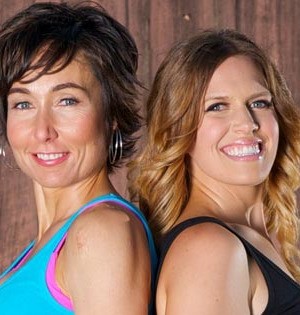- Finding Unshakable Power in a World That Wants to Pull Us ApartPosted 3 months ago
- What could a Donald Trump presidency mean for abortion rights?Posted 3 months ago
- Financial Empowerment: The Game-Changer for Women in Relationships and BeyondPosted 5 months ago
- Mental Health and Wellbeing Tips During and After PregnancyPosted 5 months ago
- Fall Renewal: Step outside your Comfort Zone & Experience Vibrant ChangePosted 5 months ago
- Women Entrepreneurs Need Support SystemsPosted 5 months ago
Stretching: Could It Actually Be Bad For Your Back? - Simply Woman

Written by The Go Fit Gals
Stretching. We are told to do it on a daily basis. We have been taught that it’s good for the body and, in particular, a flexible spine will help eliminate low back pain. But, what if stretching your low back is actually doing more harm than good? Especially if you already have low back pain. I recently got the opportunity to interview Dr. Stuart McGill, aka Dr. Spine, about stretching and what his research is saying about the topic.
Who Is Dr. Spine? If you have not heard of Dr. McGill, he is somewhat of a rock star in the health and fitness world (he’s our Mick Jagger, but a few decades younger and with a lot more facial hair). Dr. McGill is a kinesiology professor at the University of Waterloo, as well as the director of the Spine Biomechanics Laboratory.
The Spine Biomechanics is a lab dedicated to understanding how the low back functions and how it becomes injured. Then using that information the researchers formulate strategies and plans to prevent and rehabilitate low back pain.
He is also the author of two books on the spine (one more on its way next year), DVDs and has written countless papers on the subject. He’s been featured in the New York Times, McLean’s magazine, and has been quoted and interviewed for hundreds of newspapers, magazines, blogs and podcasts around the world.
Why You Can’t Have a Flexible Spine and a Strong Spine
When asked about stretching and the low back he explains that a mobile back is not necessarily a good thing. In fact, statistically those with a greater range of motion in the back actually have a greater risk of low back pain.
You see to bear load the spine needs stability and not always mobility. The muscles of the spine, he says, generally function to stop movement, while the muscles around the hips, legs, arms and shoulders create motion. If the spine isn’t stable then the limb muscles loose efficiency to create arm and leg movement at the hips and shoulders.
From a spine disc perspective, a flexible disc is more easily damaged when high loads are applied to it. In contrast, discs must be toughened and stiffened to bear high load. A powerlifter must develop a stiffer spine. It is difficult to train for both purposes so either have a flexible spine, but don’t train with heavy loads, or train with heavy loads but do not stretch the spine. Focus mobility at other joints.
When pressed for what stretches we should be doing he declined to give me a definitive answer. Dr. McGill is a one-on-one assessment guy and explains that it depends on the individual, their fitness goals, their body type and their architecture and pain history.
How To Match Your Body Type To The Right Stretches
For instance, if you are thick spined and big boned, you were never designed to bend effortlessly in the first place so a good training goal for you would be a strong spine.
But, if you are long and slender, your body type predisposes you to touching your toes and a realistic goal for you could be channelling your inner yogi.
He used the analogy of a willow branch to explain it to me. A long thin branch, like a person, will bend no problem. However, a thicker, stronger branch will either break in half completely, or at least splinter, when bent. But, it can support much more load.
Final Words From Dr. McGill
Because I couldn’t help myself I started to ask him about my back pain. I have been plagued with low back pain off and on for years and have taken up yoga, thinking that I was helping my back. (He must get so tired of that! Everyone airing his or her low back dirty laundry.)
He quickly schooled me. Apparently as we age our spines naturally stiffen. However, with all this stretching that I am doing I am slowing down the process of this stiffening, and in my case stiffening the spine joints is good. It will produce that stability that my low back needs.
He went on to scold me that I need to pick a training goal too. Do I want to be flexible, or do I want to lift heavy, what do I want out of my fitness program? Because all this “willy-nilly” in the gym is just digging my own grave and creating my own path to pain. In essence, I am my low back’s biggest enemy.
Yeah, Dr. McGill does not pull any punches.
What To Do At Home
What do I suggest you do at home? First off, if you are plagued with low back pain make sure that you see a good physiotherapist. They are best equipped to assess, diagnose and treat pain.
Second, assess your body type and figure out what your fitness goals are. From there you can start a fitness program geared to those goals (no more willy-nilly in the gym).
Third, continue to stretch the muscles around the hips and shoulders, while performing plank movements to increase the stability of the muscles around the spine.
 The Go Fit Gals are your experts in fitness and nutrition for women from new mommies to menopause. We provide the coaching and the inspiration to get our members strong, healthy and confident through our unique online programs based on eating clean and training dirty.
The Go Fit Gals are your experts in fitness and nutrition for women from new mommies to menopause. We provide the coaching and the inspiration to get our members strong, healthy and confident through our unique online programs based on eating clean and training dirty.






